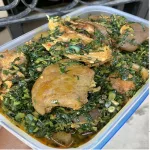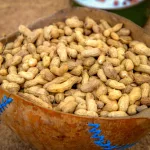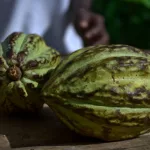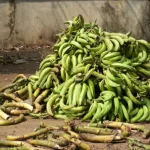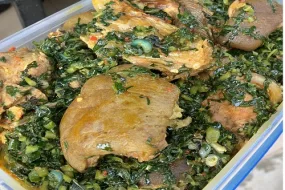Nigerian plantains are a delicious and versatile staple food in Nigeria. They are a type of banana, but they differ from the sweet bananas you might eat as a snack. Plantains are larger and starchier, making them a perfect ingredient for various dishes in Nigerian cuisine.
Nigerian plantains are typically green when unripe and turn yellow or black as they ripen. Unlike sweet bananas, plantains are not typically eaten raw, as they have a starchy and slightly bitter taste. They need to be cooked to bring out their delicious flavors and make them soft and enjoyable to eat.
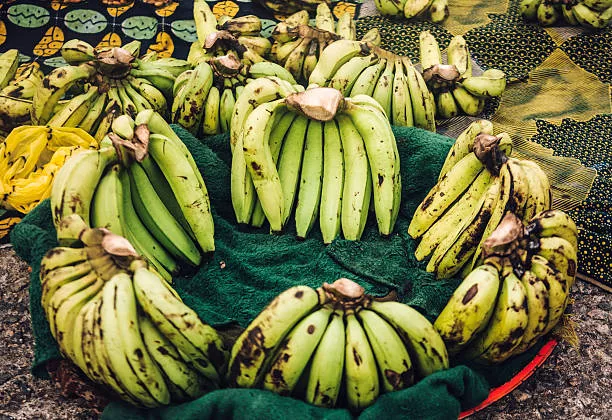
In Nigeria, plantains are used in a wide range of dishes, from savory to sweet. Here are a few popular Nigerian plantain dishes:
- Fried Plantains (Dodo): This is perhaps the most common way to prepare plantains in Nigeria. Slices of ripe or unripe plantains are deep-fried until they’re golden and crispy. Fried plantains are often served as a side dish or a snack and are loved for their sweet and savory taste.
- Boiled Plantains: Unripe plantains are peeled, cut into chunks, and boiled until they become soft. They are usually served with spicy stews, sauces, or soups.
- Plantain Chips: Thin slices of plantains are deep-fried to make crispy chips, which are a popular snack in Nigeria. They can be seasoned with various spices and flavors.
- Plantain Porridge (Kelewele): Ripe plantains are cooked with various spices and seasonings to create a sweet and spicy porridge, often served as a main dish.
- Plantain Fufu: Unripe plantains can be boiled and pounded into a dough-like consistency, similar to yam or cassava fufu. This is a common accompaniment to Nigerian soups and stews.
- Plantain Pancakes: Ripe plantains can be mashed and mixed with other ingredients to make sweet and fluffy pancakes. They are often enjoyed for breakfast.
- Plantain Mosa: A popular street food, plantain mosa is made by mixing ripe plantains with flour and deep-frying the mixture to create a delicious and sweet snack.
Nigerian plantains are not only versatile but also a great source of carbohydrates, dietary fiber, and essential nutrients. They are an integral part of Nigerian cuisine, adding flavor and texture to a wide variety of dishes. Whether you prefer them sweet or savory, you’re sure to find a Nigerian plantain dish that suits your taste buds.
Comparative Analysis of Nigerian Plantains
Let’s do a comparative analysis of Nigerian plantains, examining their characteristics and uses in relation to other common types of plantains found in different parts of the world.
Nigerian Plantains:
- Varieties: In Nigeria, both ripe and unripe plantains are popular. Unripe plantains are commonly used for savory dishes, while ripe plantains are used in sweet dishes and snacks.
- Preparation: Nigerian plantains are often fried, boiled, or used in porridge. They are also a common ingredient in soups and stews.
- Taste: Unripe plantains have a starchy and slightly bitter taste, while ripe plantains are sweet and soft when cooked.
- Common Dishes: Nigerian plantains are used in dishes like Fried Plantains (Dodo), Boiled Plantains, Plantain Chips, Plantain Porridge (Kelewele), Plantain Fufu, Plantain Pancakes, and Plantain Mosa.
Comparative Analysis with Latin American Plantains:
- Varieties: In Latin America, the most common types of plantains are green (unripe) and yellow (ripe) plantains. Both are used in various dishes, but green plantains are often preferred for frying, while yellow ones are used for sweeter recipes.
- Preparation: Latin American green plantains are commonly used to make Tostones (fried green plantains) and other savory dishes. Ripe plantains are used in dishes like Maduros, which are sweet and caramelized.
- Taste: Green plantains have a starchy, slightly nutty taste when fried. Ripe plantains are sweet and soft, similar to ripe Nigerian plantains.
- Common Dishes: Latin American plantains are used in dishes like Tostones, Mofongo, Maduros, and Plantain Chips. They can be both savory and sweet, similar to Nigerian plantains.
Comparative Analysis with Caribbean Plantains:
- Varieties: In the Caribbean, plantains are widely used in both green (unripe) and ripe forms. Green plantains are popular for frying, while ripe ones are used in sweet dishes and snacks.
- Preparation: Green plantains are used in dishes like Tostones and Alcapurrias. Ripe plantains are used for dishes like Plátanos en Tentación.
- Taste: Green plantains in Caribbean cuisine are starchy and slightly savory, especially when fried. Ripe plantains are sweet and used for dessert-like dishes.
- Common Dishes: Caribbean plantains are used in dishes like Tostones, Mofongo, Alcapurrias, and Plátanos en Tentación. They share similarities with Nigerian plantains in terms of both savory and sweet applications.
Nigerian plantains are versatile, with both unripe and ripe plantains used in a wide range of dishes. While the taste of green (unripe) plantains can be slightly bitter and starchy, ripe plantains are sweet and soft. Their usage in Nigerian cuisine spans from savory to sweet, making them a fundamental ingredient in various dishes. While there are regional variations in plantain usage, the characteristics and culinary applications of plantains are somewhat similar across different parts of the world, with some distinctions in taste and specific dishes.
Nutritional Properties of Nigerian plantains:
1. Carbohydrates:
Plantains are a rich source of carbohydrates, making them an excellent energy source. The carbohydrates in plantains are mainly in the form of complex carbohydrates, which provide a steady release of energy.
2. Dietary Fiber:
Plantains are high in dietary fiber, which is beneficial for digestive health. Fiber helps prevent constipation, aids in regular bowel movements and supports overall gut health.
3. Vitamins:
- Vitamin C: Ripe plantains contain vitamin C, an antioxidant that supports the immune system and skin health.
- Vitamin A: Ripe plantains also provide vitamin A, which is essential for good vision, skin, and overall immune function.
4. Minerals:
- Potassium: Plantains are a good source of potassium, a mineral that plays a crucial role in maintaining healthy blood pressure, heart function, and muscle contractions.
- Magnesium: Magnesium in plantains supports bone health, muscle function, and helps regulate blood sugar levels.
5. Resistant Starch:
Unripe plantains contain resistant starch, which is not easily digested in the small intestine. This type of starch has a prebiotic effect, promoting the growth of beneficial gut bacteria and potentially improving gut health.
6. Antioxidants:
Plantains contain various antioxidants, such as beta-carotene and flavonoids, which help protect the body’s cells from damage caused by free radicals.
7. Calories:
Plantains are relatively calorie-dense due to their carbohydrate content, making them an excellent choice for energy, especially for individuals with active lifestyles.
8. Low in Fat and Cholesterol:
Plantains are low in both fat and cholesterol, making them a heart-healthy food option.
9. Protein:
While plantains are not a significant source of protein, they do provide some, especially when compared to other starchy staples like rice or cassava.
10. Allergen-Free:
Plantains are not a common allergen, making them a safe choice for individuals with food allergies.
Proximate Analysis of raw, sundried, fermented, boiled, and roasted plantain (g/100 g)
| Sample | Raw | Sundried | Fermented | Boiled | Roasted plantain |
| Moisture | 59.4 ± 0.02 | 11.1 ± 0.03 | 11.2 ± 0.02 | 62.6 ± 0.03 | 47.3 ± 1.10 |
| Crude Protein | 7.7 ± 0.13 | 16.9 ± 0.12 | 3.4 ± 0.16 | 7.5 ± 0.09 | 3.3 ± 0.10 |
| Crude Lipid | 1.5 ± 0.02 | 3.9 ± 0.03 | 1.7 ± 0.01 | 3.8 ± 0.02 | 1.0 ± 0.02 |
| Ash |
1.4 ± 0.02
|
1.5 ± 0.01 | 0.8 ± 0.02 | 1.3 ± 0.02 | 2.4 ± 0.03 |
| Crude Fibre | 1.4 ± 0.02 | 3.8 ± 0.03 | 2.5 ± 0.02 | 1.5 ± 0.01 | 1.3 ± 0.02 |
| Carbohydrates | 24.4 ± 0.19 | 60.2 ± 0.11 | 78.5 ± 0.15 | 18.8 ± 0.11 | 44.8 ± 1.19 |
|
Gross Energy (kcal/)
|
148.6 ± 0.14 | 350.5 ± 0.28 |
350.9 ± 0.14
|
144.4 ± 0.22 | 169.0 ± 1.00 |
It’s important to note that the nutritional content of plantains may vary slightly depending on their ripeness. Ripe plantains tend to be higher in sugars and calories, while unripe plantains are starchier and lower in sugars. The cooking method can also affect the nutritional content. For instance, frying plantains add extra calories due to the oil used.
Nigerian plantains are a valuable addition to a balanced diet due to their rich carbohydrate content, dietary fiber, vitamins, and minerals. They provide energy, support digestive health, and offer various essential nutrients, making them a popular and nutritious staple in Nigerian cuisine.
Health Benefits of Nigerian plantains:
Nigerian plantains offer several health benefits when consumed as part of a balanced diet. Here are some of the key health benefits of Nigerian plantains:
1. Good Source of Complex Carbohydrates:
Plantains are a rich source of complex carbohydrates, providing a steady release of energy. They can help maintain consistent blood sugar levels and keep you feeling full and energized for longer periods.
2. High in Dietary Fiber:
Plantains are high in dietary fiber, which aids in digestive health. Fiber promotes regular bowel movements, prevents constipation, and supports a healthy gut by nourishing beneficial gut bacteria.
3. Nutrient-Rich:
Plantains contain essential vitamins and minerals, including vitamin C, vitamin A, potassium, and magnesium. These nutrients contribute to overall health, including immune function, skin health, heart health, and bone health.
4. Heart Health:
The potassium content in plantains is beneficial for heart health. Adequate potassium intake can help regulate blood pressure and reduce the risk of hypertension and stroke.
5. Supports Weight Management:
The fiber in plantains can help with weight management by promoting a feeling of fullness, which can lead to reduced overall calorie intake.
6. Rich in Resistant Starch:
Unripe plantains are a source of resistant starch, a type of starch that isn’t easily digested in the small intestine. This can have a positive impact on gut health by promoting the growth of beneficial gut bacteria.
7. Antioxidant Properties:
Plantains contain antioxidants, such as beta-carotene and flavonoids, which help protect the body’s cells from oxidative stress and free radical damage.
8. Skin Health:
Vitamin A, present in ripe plantains, is essential for healthy skin, promoting a radiant complexion and supporting skin repair and regeneration.
9. Immune Support:
The vitamin C in ripe plantains contributes to a healthy immune system, helping the body fight off infections and illnesses.
10. Bone Health:
Magnesium, found in plantains, is crucial for maintaining healthy bones and muscles.
11. Low in Fat and Cholesterol:
Plantains are naturally low in fat and cholesterol, making them a heart-healthy food choice.
12. Versatile Ingredient:
Nigerian plantains can be prepared in various ways, allowing for a wide range of culinary possibilities. This versatility makes it easier to incorporate them into a diverse and balanced diet.
Chemical Properties of Nigerian plantains:
1. Carbohydrates:
Plantains are primarily composed of carbohydrates, which make up the majority of their chemical composition. The main carbohydrate in plantains is starch, which accounts for their starchy and slightly bitter taste when unripe.
2. Sugars:
As plantains ripen, the starch content is gradually converted into sugars, primarily glucose and fructose. This transformation from starch to sugar is responsible for the sweet taste of ripe plantains.
3. Fiber:
Plantains are a good source of dietary fiber, which includes both soluble and insoluble fiber. Fiber plays a crucial role in digestive health and contributes to the overall chemical composition of the fruit.
4. Vitamins:
- Vitamin C: Ripe plantains contain vitamin C (ascorbic acid), which is an antioxidant that helps protect cells from damage and supports the immune system.
- Vitamin A: Ripe plantains also contain vitamin A (in the form of beta-carotene), which is important for vision, skin health, and immune function.
5. Minerals:
- Potassium: Plantains are a good source of potassium, which is an essential mineral for maintaining healthy blood pressure and heart function.
- Magnesium: Magnesium is present in plantains and plays a role in bone health and muscle function.
6. Resistant Starch:
Unripe plantains contain resistant starch, a type of starch that resists digestion in the small intestine. It behaves more like dietary fiber, promoting gut health and potentially offering various health benefits.
7. Antioxidants:
Plantains contain antioxidants, including various flavonoids and phenolic compounds, which help protect cells from oxidative stress and reduce the risk of chronic diseases.
8. Phytochemicals:
Plantains also contain phytochemicals such as phytosterols, which have been associated with cholesterol-lowering effects.
9. Alkaloids:
Some unripe plantains contain small amounts of alkaloids like tannins and saponins. These compounds are responsible for the slightly bitter taste of unripe plantains.
It’s worth noting that the chemical composition of plantains can vary depending on factors such as the stage of ripeness, variety, and growing conditions. For example, unripe plantains have a higher starch content, while ripe plantains are higher in sugars.
These chemical properties make plantains not only a source of energy but also a fruit with potential health benefits, including support for digestive health, heart health, and immune function. While the chemical composition is interesting, it’s important to enjoy plantains as part of a balanced diet to fully experience their nutritional and health advantages.
Mineral composition of Raw, Sundried, Fermented, Boiled, and Roasted plantain (mg/100g Edible portion)
| Sample | Raw | Sundried | Fermented | Boiled | Roasted plantain |
| Sodium | 200.0 ± 1.41 | 245.0 ± 21.21 | 85.5 ± 2.12 | 195.0 ± 21.21 | 55.7 ± 1.15 |
| Potassium | 370.0 ± 14.41 | 380.0 ± 21.21 | 160.0 ± 14.14 | 365.0 ± 14.14 | 270.0 ± 1.00 |
| Calcium | 126.5 ± 2.12 | 140.0 ± 3.50 | 77.5 ± 2.12 | 93.0 ± 2.83 | 160.0 ±10.00 |
| Magnesium | 375.0 ± 21.21 | 405.0 ± 15.36 | 195.2 ± 12.21 | 340.0 ± 14.14 | 350.0 ± 13.61 |
| Iron | 2.53 ± 0.03 | 3.50 ± 0.02 | 1.38 ± 0.02 | 2.45 ± 0.04 | 3.48 ± 0.01 |
| Phosphorus | 220.0 ± 21.21 | 225.0 ± 17.43 | 165.0 ± 11.21 | 190.0 ± 14.14 | 217.0 ± 11.16 |
| Zinc | 3.74 ± 0.02 | 3.66 ± 0.02 | 3.13 ± 0.01 | 3.60 ± 0.02 | 3.70 ± 0.02 |
| Manganese | 2.99 ± 0.05 | 2.74 ± 0.03 | 2.47 ± 0.02 | 2.65 ± 0.03 | 2.80 ± 0.02 |
| Copper | 1.66 ± 0.04 | 1.74 ± 0.02 | 1.47 ± 0.02 | 2.20 ± 0.02 | 1.60 ± 0.01 |
It’s important to note that while plantains offer numerous health benefits, the way they are prepared can impact their overall nutritional profile. For example, frying plantains adds extra calories and fats due to the cooking oil used. Therefore, healthier cooking methods, such as boiling or baking, can help maximize their nutritional benefits.
Including Nigerian plantains in your diet can contribute to a well-rounded and nutritious meal plan, supporting overall health and well-being.
Physical Properties of Nigerian plantains:
1. Appearance:
- Color: Nigerian plantains change in color as they ripen. Unripe plantains are green, while ripe plantains turn yellow with dark spots. Overripe plantains can become almost entirely black.
- Size and Shape: Plantains are larger and more elongated than typical sweet bananas. They can range from 6 to 12 inches in length and have a thick, firm, and angular shape.
2. Texture:
- Unripe Plantains: Unripe plantains have a tough and firm texture. They are difficult to cut and have a starchy, dry feel when touched.
- Ripe Plantains: Ripe plantains have a much softer texture. They yield to gentle pressure, and the skin may become thinner and easier to peel.
3. Skin:
- Thickness: The skin of plantains is thicker than that of sweet bananas. It protects the fruit and must be peeled before consumption.
- Texture: The skin is slightly rough and can have ridges and bumps. It becomes smoother as the plantain ripens.
4. Weight:
- Heavier than Sweet Bananas: Plantains are denser and heavier than sweet bananas of similar size. This is due to their higher starch content.
5. Aroma:
- Unripe Plantains: Unripe plantains typically have a mild, slightly grassy aroma.
- Ripe Plantains: Ripe plantains emit a sweet, tropical fragrance, especially when they are fully ripe and have turned yellow with dark spots.
6. Taste:
- Unripe Plantains: Unripe plantains have a starchy and slightly bitter taste. They are not sweet and are commonly used in savory dishes.
- Ripe Plantains: Ripe plantains are sweet and have a distinct tropical flavor when cooked. They are often used in sweet dishes and snacks.
7. Sound:
- When Tapped: Ripe plantains make a dull, hollow sound when tapped, which is a sign that they are ready to be cooked.
8. Ripening:
- Natural Ripening: Plantains ripen naturally over time. Unripe green plantains will turn yellow and eventually develop dark spots as they ripen.
- Forced Ripening: To speed up the ripening process, plantains can be placed in a brown paper bag with an apple or a ripe banana, as these fruits release ethylene gas, which accelerates ripening.
9. Maturity and Quality:
- The best quality plantains are those that are fully ripe or at the desired level of ripeness for the intended recipe. Overripe plantains may become too soft and overly sweet for some dishes.
Understanding the physical properties of Nigerian plantains is essential for selecting the right fruit for various culinary purposes, as the ripeness and texture of the plantain can significantly impact the final outcome of a dish. Whether you prefer them unripe for savory dishes or ripe for sweet treats, plantains are a versatile and distinctive fruit with a range of applications in Nigerian cuisine.
Ways to Use Nigerian plantains:
Nigerian plantains are incredibly versatile and can be used in various delicious ways. Here are some popular ways to use Nigerian plantains in your culinary adventures:
- Fried Plantains (Dodo): This is one of the most beloved ways to prepare plantains in Nigeria. Slice ripe or unripe plantains and deep-fry them until they are golden brown and crispy. Sprinkle a bit of salt on top for extra flavor. Fried plantains can be served as a side dish or a tasty snack.
- Boiled Plantains: Unripe plantains are peeled, cut into chunks, and boiled until they become soft. These boiled plantains are commonly served with spicy stews, sauces, or soups.
- Plantain Chips: Thin slices of plantains can be deep-fried or baked to create crispy chips. You can season them with various spices or salt for added flavor.
- Plantain Porridge (Kelewele): Ripe plantains are cooked with spices, peppers, and other seasonings to create a sweet and spicy porridge. It’s a flavorful and comforting dish that’s often enjoyed as a main course.
- Plantain Fufu: Unripe plantains are boiled, mashed, and pounded into a dough-like consistency, similar to yam or cassava fufu. This is a common accompaniment to Nigerian soups and stews.
- Plantain Pancakes: Ripe plantains can be mashed and combined with other ingredients like flour, eggs, and sugar to make sweet and fluffy pancakes. They make for a delicious breakfast treat.
- Plantain Mosa: A popular street food, plantain mosa is made by blending ripe plantains with flour and deep-frying the mixture into small, fritter-like bites. These are sweet and delightful snacks.
- Plantain Slices in Stews: You can add sliced plantains to various stews and soups, which infuse the dish with a unique flavor and texture. They absorb the delicious flavors of the stew while providing a different mouthfeel.
- Grilled Plantains: Ripe plantains can be sliced lengthwise and grilled to achieve a smoky, caramelized flavor. This method of cooking enhances their natural sweetness.
- Plantain Sandwiches: Ripe plantain slices can be used as a substitute for bread to create unique sandwich variations. Fill them with your favorite ingredients like meats, vegetables, and sauces.
- Plantain Desserts: Ripe plantains are a key ingredient in various dessert recipes. You can use them in dishes like plantain pudding, plantain tarts, and plantain cake.
- Plantain Smoothies: Blend ripe plantains with other fruits, yogurt, and a touch of honey for a creamy and nutritious smoothie.
- Plantain and Egg Breakfast: Make a hearty breakfast by cooking plantains with scrambled or fried eggs. It’s a simple and satisfying morning meal.
These are just a few ways to use Nigerian plantains in your cooking. The versatility of plantains allows them to be incorporated into both savory and sweet dishes, making them a fantastic addition to your culinary repertoire. Enjoy exploring the diverse world of plantain-based recipes!
Recipes Using Nigerian plantains:
Here are a couple of delicious recipes using Nigerian plantains:
1. Nigerian Fried Plantains (Dodo):
Fried plantains, known as “Dodo” in Nigeria, are a classic and beloved snack or side dish. This recipe is simple and perfect for enjoying the sweet and savory flavors of ripe or unripe plantains.
Ingredients:
- 2-3 ripe or unripe plantains
- Vegetable oil for frying
- Salt, to taste
Instructions:
- Peel the plantains and slice them into diagonal or round shapes, about 1/2 inch thick.
- Heat vegetable oil in a deep frying pan or pot over medium heat.
- When the oil is hot (around 350°F or 175°C), carefully add the plantain slices in batches, ensuring they are not overcrowded.
- Fry the plantains until they are golden brown and crispy, usually about 2-3 minutes per side.
- Remove the fried plantains and place them on paper towels to drain excess oil.
- Sprinkle a pinch of salt on the fried plantains (optional) for added flavor.
- Serve your delicious dodo as a snack or side dish.
2. Nigerian Plantain and Peppersoup:
This is a spicy and comforting soup made with plantains and assorted meat. It’s perfect for a hearty and satisfying meal.
Ingredients:
- 2-3 unripe plantains, peeled and cut into chunks
- Assorted meat (beef, goat meat, or tripe)
- Pepper soup spices (scent leaves, uziza, or basil leaves)
- Ground crayfish
- Scotch bonnet peppers (to taste)
- Onions
- Stock cubes
- Salt to taste
- Water
Instructions:
- In a pot, combine the assorted meat with water, chopped onions, and salt. Cook until the meat is tender.
- Add the plantains to the pot and continue cooking until they become soft, about 15-20 minutes.
- In a blender, combine the peppers, onions, and a bit of water. Blend to form a pepper paste.
- Add the pepper paste, ground crayfish, and pepper soup spices to the pot. Adjust the seasoning to your taste.
- Simmer the soup for an additional 10-15 minutes, allowing the flavors to meld.
- Serve hot, garnished with fresh herbs like scent leaves, uziza, or basil leaves.
These recipes are just a taste of the culinary possibilities that Nigerian plantains offer. Whether you’re in the mood for a crispy and sweet snack or a hearty, spicy soup, Nigerian plantains can be used in diverse and delightful ways. Enjoy your cooking!
Potential Side Effects of Nigerian Plantains and Things to Remember
1. Allergies:
Some individuals may be allergic to plantains, although plantain allergies are relatively rare. If you experience symptoms like itching, hives, swelling, or difficulty breathing after consuming plantains, seek medical attention immediately.
2. High Caloric Content:
Ripe plantains are relatively high in calories due to their carbohydrate content, particularly sugars. If you’re watching your calorie intake or managing your weight, be mindful of portion sizes, especially when enjoying sweet plantain dishes.
3. Digestive Issues:
Unripe plantains, which are high in resistant starch, can cause digestive discomfort in some people, leading to gas, bloating, or stomach upset. Cooking or ripening the plantains can reduce the starch content and may alleviate these issues.
4. Frying Concerns:
While fried plantains (Dodo) are delicious, deep-frying them in oil adds extra calories and fats. Consuming fried plantains in moderation is a healthier choice compared to frequent indulgence.
5. Ripeness Matters:
The taste and nutritional content of plantains vary with their ripeness. Ripe plantains are sweeter, while unripe ones are starchier and less sweet. Consider your recipe and personal preferences when choosing the right level of ripeness.
6. Spicy Dishes:
Some Nigerian plantain dishes, like plantain porridge and peppersoup, can be quite spicy. If you are sensitive to spicy foods or have gastrointestinal issues, be cautious with the level of spiciness in your dishes.
7. Moderation:
While plantains can be a nutritious part of a balanced diet, like any food, they should be consumed in moderation. Balancing your diet with a variety of foods is key to overall health.
8. Preparation Hygiene:
Ensure that plantains are peeled and prepared in a clean and sanitary environment to prevent contamination and foodborne illnesses.
9. Personal Health Considerations:
If you have specific health conditions, such as diabetes or hypertension, consult with a healthcare professional or a registered dietitian to incorporate plantains into your diet safely and in a way that aligns with your health goals.
10. Dietary Preferences:
If you follow dietary preferences, such as vegetarian or vegan diets, plantains can be a great addition to your meals. Just be sure to pair them with other suitable ingredients to meet your nutritional needs.
It’s essential to remember that plantains, when included in a balanced and varied diet, can be a tasty and nutritious addition. It’s crucial to be mindful of your individual dietary needs, preferences, and any potential sensitivities when enjoying Nigerian plantains.
In conclusion, Nigerian plantains are a versatile and delicious staple in Nigerian cuisine. Whether you prefer them sweet or savory, there’s a wide array of dishes and cooking methods to explore. Here’s the bottom line on Nigerian plantains:
- Nutritional Powerhouses: Nigerian plantains are rich in complex carbohydrates, dietary fiber, vitamins (such as vitamin C and A), and essential minerals (potassium and magnesium).
- Health Benefits: They offer various health benefits, including support for heart health, digestive health, immune function, and more.
- Diverse Uses: Nigerian plantains can be used in an extensive range of recipes, from fried plantains (Dodo) and plantain porridge (Kelewele) to plantain chips and sweet plantain desserts.
- Moderation is Key: While plantains are nutritious, it’s crucial to enjoy them in moderation, especially when considering calorie content and preparation methods like frying.
- Personalization: The ripeness of the plantains and your personal dietary preferences play a significant role in how you use them in your meals.
- Side Effects and Precautions: Be aware of potential side effects, such as digestive discomfort with unripe plantains, and remember to maintain good preparation hygiene and follow dietary recommendations tailored to your individual health needs.
In a nutshell, Nigerian plantains are a delightful and nutritious addition to your culinary repertoire, offering a balance of flavors and versatility. Whether you’re cooking for your family or exploring the world of Nigerian cuisine, plantains can add a unique and delectable touch to your meals. Enjoy your culinary adventures with this beloved African fruit!
REFERENCES
Oloyede, O. I. (2018). Proximate and Mineral Composition of Unripe and Ripe Plantain (Musa spp.). Journal of Agricultural Sciences, 63(1), 15-22.Adepoju, O. T., & Nwagbara, M. O. (2019).
Nutritional Evaluation and Phytochemical Screening of Unripe Plantain (Musa paradisiaca) Flour. Food Science & Nutrition, 7(2), 734-741.Adejuyitan, J. A., & Otunola, G. A. (2019).
Unripe Plantain (Musa paradisiaca) in Human Nutrition. In Functional Food and Human Health (pp. 113-132). CRC Press.Jimoh, O. S., & Olagunju, A. I. (2017).
Potential Health Benefits of Plantain (Musa paradisiaca). Journal of Pharmacognosy and Phytochemistry, 6(6), 570-574. Oluwole, O. B., Oyetoro, O. A., & Adebowale, A. A. (2019).
Effects of Ripening on the Physical and Chemical Properties of Cooking Bananas and Plantains. Food Science & Nutrition, 7(8), 2775-2783.
Oyeleke, G. O., & Onimawo, I. A. (2005). Effect of Ripeness on the Physicochemical and Functional Properties of Plantain (Musa paradisiaca) Flour. Food Chemistry, 93(3), 425-432.
Imasuen, A. I., & Isah, E. C. (2020). Development of Plantain (Musa paradisiaca) Cake. Journal of Food Processing and Preservation, 44(7), e14574.
Daramola, B., Okanlawon, T. J., & Suleiman, A. S. (2018). Development and Sensory Evaluation of Plantain and Cowpea Pudding. Food Science & Nutrition, 6(3), 656-661.
Akubor, P. I., & Ukwuru, M. U. (2012). Effect of Pre-Treatment on the Drying Characteristics of Plantain (Musa paradisiaca) Slices. Food and Bioprocess Technology, 5(4), 1402-1410.
Obadina, A. O., Oyewole, O. B., & Odunbaku, L. A. (2015). Effect of Maturity on the Physicochemical and Sensory Properties of Plantain (Musa paradisiaca) Chips. Food Science & Nutrition, 3(4), 337-343.

